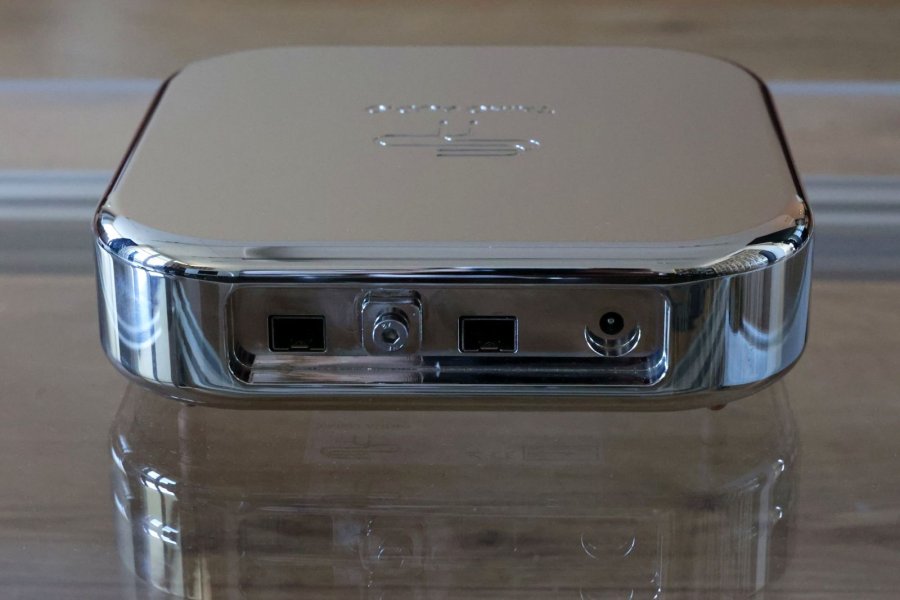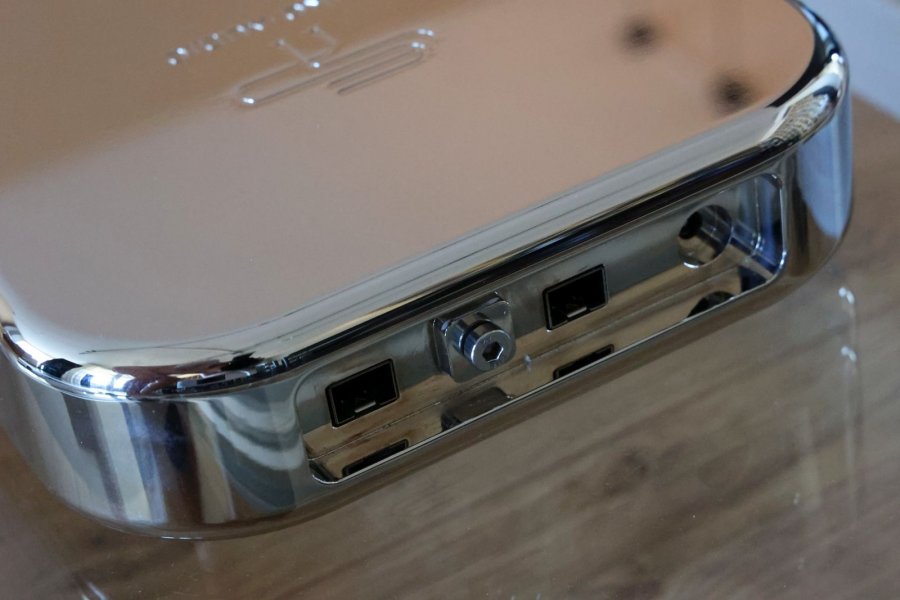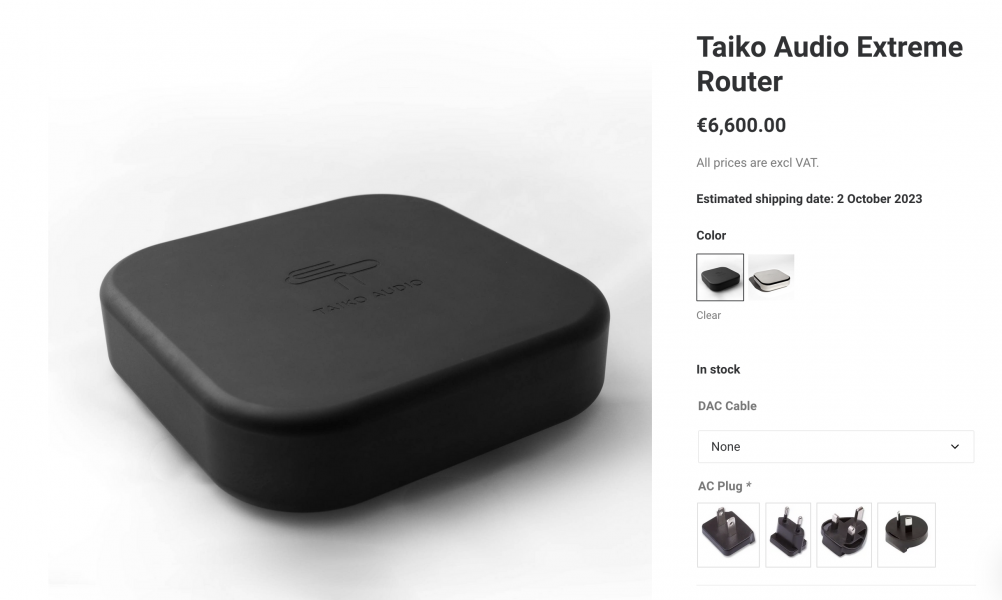...oh sure, I get that bit having added the new card, @Christiaan Punter but it's the disconnecting of the "old" cable I think I missed as an improvement, if previously noted.
Taiko Audio SGM Extreme : the Crème de la Crème
- Thread starter CKKeung
- Start date
You are using an out of date browser. It may not display this or other websites correctly.
You should upgrade or use an alternative browser.
You should upgrade or use an alternative browser.
Christiaan Punter
Well-Known Member
Hi John, you make a valid point. In the Netherlands where I live, most current buildings and apartments have solid concrete floors, as is the case for me. I have vinyl planking on a thin insulating layer and it's very solid. Wooden floors on the other hand will very likely lead to different results, especially when the rack's feet are on springy parts of the floor. As always, it's worth experimentingIsolation can be an interesting topic, and Christiaan I couldn't agree more with your comment "these are good times to be an audiophile". Back to isolation, the substrate in your house or apartment has a lot to do with this. Ideally a 6" poured slab would be the ticket. With My situation the floor joists are 2" X 12", 16" on center. On top of the joists sits 3/4" sheeting. On top of the sheeting is 3/4" pine tongue and groove. Insolation between the joists along with bracing of the joists. All of this sits on concrete columns along with block/ brick foundation. The point I am attempting to make is isolation can be less finnicky in certain situations. If the audio platform or rack sits on a substrate that is susceptible to vibration different isolation applications will have different results...After thought: The best substrate you can possibly have won't matter if your components sit on a cardboard box...
Christiaan Punter
Well-Known Member
Ah, I see! Yes, that may not yet have been mentioned before... I will see if I can add this to the documentation....oh sure, I get that bit having added the new card, @Christiaan Punter but it's the disconnecting of the "old" cable I think I missed as an improvement, if previously noted.
Well, it makes a surprisingly large difference! The switch already does make a difference (and quite a large one at that) but you won't hear the full extent in terms of transparency, cleanness, spaciousness, and expression, when the UTP cable is disconnected from the LAN 1 port and only the DAC cable is connected.
Christiaan Punter
Well-Known Member
Ok thanks, so the 1m and 3m cables are indeed the same.10G SFP+ Passive Direct Attach Copper Twinax Cable
0.5m (2ft) - 3m (10ft) = 30 AWG
4m+ (13.12 ft) = 24 AWG (SFP version = 26AWG)
Correct, but I have to double check. There is a 4m 10G SFP+ Passive Direct Attach Copper Twinax Cable with 24 AWG up to 7m. But I do not have your specs at hand. I need to be 100% sure so I deleted the second you replied.Ok thanks, so the 1m and 3m cables are indeed the same.
If this is the one you were using in the above test: FS P/N: SFPP-PC03 ? it comes also in 24 AWG
30AWG for ?3m,
24AWG for 4~7m as default
(Ha! I can hear Emile thinking, will this cable & feet swapping ever stop? HE probably knows it will though!!)
What Factors to Consider When Buying Twinax SFP+ Cable?
Wire AWG - 30/28/26/24 AWG
DAC cables in the market are available for 30AWG, 28AWG ( 7/0.12mm), and 24AWG (7/0.20mm). Bigger AWG has a smaller bend radius. Wire AWG also influences the cable length, one rule of thumb — the longer the reach, the smaller the AWG. So remember to check the cable installation environment and link distance, pick an AWG value to meet the bending requirement, and be cautious not to exceed the minimum bend radius in a real application.
Last edited:
Indeed wood is a different animal. My walls (square logs) are 6" thick which help "tie" it all together. For sure on the experimenting. My Extreme sits on a 6" thick concrete platform with cork adhered to the bottom along with isoacoustics footers. Same application without platform, just placed on the floor with the footers, different presentation. Drawing up the plans for a new rack just for the network. 100 year old 4" thick red oak.Hi John, you make a valid point. In the Netherlands where I live, most current buildings and apartments have solid concrete floors, as is the case for me. I have vinyl planking on a thin insulating layer and it's very solid. Wooden floors on the other hand will very likely lead to different results, especially when the rack's feet are on springy parts of the floor. As always, it's worth experimenting
I have gone as far as to consider placing lally columns under the house under the listening area. Lally columns are nothing more than threaded steel posts with plates on top and bottom. The objective is to "further tighten" things up. You literally turn the up plate as if you are jacking up a car. If I ever do this I would not object to financial help with psychological counseling...
Christiaan Punter
Well-Known Member
As requested by davidavdavid in a PM, here is the backside of the Extreme Network Switch. Shown here without any adapter modules in the SFP slots.




Christiaan Punter
Well-Known Member
Interesting idea for the Lally Columns! I'm sure it will make a difference. But I'm also (almost) sure that it may be a bridge too far;-) Such a solution may have a person tightening and loosening individual pressure points throughout the seasons as the wood expands and "works"... the stuff of audiophile nightmares!Indeed wood is a different animal. My walls (square logs) are 6" thick which help "tie" it all together. For sure on the experimenting. My Extreme sits on a 6" thick concrete platform with cork adhered to the bottom along with isoacoustics footers. Same application without platform, just placed on the floor with the footers, different presentation. Drawing up the plans for a new rack just for the network. 100 year old 4" thick red oak.
I have gone as far as to consider placing lally columns under the house under the listening area. Lally columns are nothing more than threaded steel posts with plates on top and bottom. The objective is to "further tighten" things up. You literally turn the up plate as if you are jacking up a car. If I ever do this I would not object to financial help with psychological counseling...
Christiaan Punter
Well-Known Member
As a general clarification, when I indicate that the Extreme Switch + Network card and the DAC cable connection sound best when the RJ45 UTP cable is removed, I mean that one simply pulls the "normal" ethernet cable from the Extreme's LAN 1 port, leaving only the DAC cable connected. In other words, do not connect the Extreme via 2 network connections simultaneously.
...thank you. No ambiguity in that explanation, Christiaan. I was wondering/thinking you were perhaps referring to something internally. Cheers.
Well I think I can give an opinion on the two FS DAC cables, 2 meters 30 AWG vs 5 meters 24 AWG. In principle I agree with Christian's opinion:
“Ok, so, is there a sonic difference between the two? Well, I do indeed hear a difference, but it is very subtle. What I hear is that the bass is slightly tighter and more articulate with the 1-meter cable and slightly fuller and rounder with the 3-meter cable. But again, these differences are very subtle and infinitely smaller than the differences observed between the various feet.”
Only here, perhaps because of the difference in wire gauge, they weren't as subtle. I would add that (in my system) this rounding of the bass is accompanied by a change in tonal balance, with less aeration and a less credible piano. Although in thin recordings the 5 meter cable can be nice, in the end I prefer the 2 meter cable.
“Ok, so, is there a sonic difference between the two? Well, I do indeed hear a difference, but it is very subtle. What I hear is that the bass is slightly tighter and more articulate with the 1-meter cable and slightly fuller and rounder with the 3-meter cable. But again, these differences are very subtle and infinitely smaller than the differences observed between the various feet.”
Only here, perhaps because of the difference in wire gauge, they weren't as subtle. I would add that (in my system) this rounding of the bass is accompanied by a change in tonal balance, with less aeration and a less credible piano. Although in thin recordings the 5 meter cable can be nice, in the end I prefer the 2 meter cable.
I compared 1 meter and 2 meter. If someone changed between the two without me knowing I most likely could not distinguish between the two different lengths. All though I did go with the 2m...It probably won't change much but I just ordered a 2 meter SPF 1G DAC cable. In this case the fun is not expensive.
Taiko Audio Extreme Network Switch and Extreme Network Card Review
Plus additional tests with various Supports and Footers
(PART 2)
Soft/Compliant Couplers
View attachment 112263
Just to see what will happen and to register more data points for future reference, I also tried a range of soft-coupling compliant feet, as opposed to the hard couplers used up to this point.
Neoprene Pads
View attachment 112264
First up are three stacks of two Neoprene pads (hard synthetic rubber) that are normally supplied with Artesania racks as one of 3 possible interfaces to choose between when using their racks. Such pads can sometimes also be found under equipment feet.
As anticipated, these pads are no improvement. The bass becomes “zoomy”, fatter and thicker but the overall sound is messier and more diffuse but does not become more fluid in the process and the overall result is just a little dull, clearly no improvement over the standard copper feet.
Sorbothane pads
View attachment 112265
Next up are three stacks of two Sorbothane pads, the super-compliant, sometimes even sticky, pads that came with classic Jeff Rowland equipment. Similar pads can be found on the bottom of IsoAcoustics feet.
Surprisingly, these ultra-soft feet provide much clearer and more well-defined bass with no booming or zooming and actually increased definition compared to the Neoprene pads. Dynamically a little comparted, the sound is not as expressive or lively as with the Switch’s own copper feet or any of the other hard couplers but there’s a very seductive refinement and alluring free-flowing quality with lots of magic to suck the listener into the music. Unexpectedly, not bad at all!
VibraPods
View attachment 112266
Remember these? They were all the rage in the nineties as cheap but effective tweaks. Again, given prior experience, I did not expect much, but the VibraPods were far from bad under the Extreme Switch. The bass further tightened up and the midrange became more defined and expressive but the treble becomes less refined and the level of magic is somewhat reduced. Overall, not the best I think, but still surprisingly ok and may be usable in certain circumstances.
Back to standard Copper feet
View attachment 112267
View attachment 112268
Finally, going back to the Switch’s own copper feet, the sound is remarkably robust and ballsy with a powerful lower midrange and great expression albeit less airy and refined than with the compliant feet, or indeed the Darkz feet. Compared with the latter, the standard copper feet provide a less spacious acoustic and an overall slightly boomy or bombastic character, but overall, I have to say the standard feet are well-chosen as a starting point that I suspect will work well with a wide range of support materials.
View attachment 112270
DAC Cable Length
With the Extreme Switch, I requested a 1-meter cable and a 3-meter cable. Mostly, to allow the freedom of positioning in various review setups, but secondarily, this allows a comparison between the two. These two cables are both standard models that can be purchased from the Taiko site. They have the same outer diameter and presumably have the same materials, construction, and conductor size internally (happy to be corrected, though).
Ok, so, is there a sonic difference between the two? Well, I do indeed hear a difference, but it is very subtle. What I hear is that the bass is slightly tighter and more articulate with the 1-meter cable and slightly fuller and rounder with the 3-meter cable. But again, these differences are very subtle and infinitely smaller than the differences observed between the various feet.
Remember I mentioned that my friend Wouter is less susceptible to very small differences? Well, this is one such case where he could not tell the difference between the short and the long cable, not even when I explained what to listen for. And I will admit that I may not notice it when someone would switch cables behind my back between two listening sessions. As such, I would say this aspect can safely be ignored by most, or kept in mind for those who are as obstinately obsessive as I am.
More to come
As I get my hands on more supports, racks, and feet, I will keep experimenting with the Switch and I will report my findings. For instance, I will be receiving a Callas Audio Bamboo + Carbon Fiber Soundboard in the near future and I will be most interested to hear how the Switch will perform with that as a support. Likewise, I will add my experiences with the DC Distributor and the Router if and when I receive them. Meanwhile, I wish everyone happy listening. These are good times to be an audiophile!
@christian--maybe i missed this, but what are you using to power the switch in these experiments?
Please note that the cable I have ordered to test is SPF, not SPF+ ie 1G and not 10G.I compared 1 meter and 2 meter. If someone changed between the two without me knowing I most likely could not distinguish between the two different lengths. All though I did go with the 2m...
Are there plans to offer the router in black?
Are there plans to offer the router in black?
Taiko Audio Extreme Router – Taiko Audio

Steve Z
The good news - my Extreme arrived today
The not so good news, I need the log-in credentials to set it up. I don't know if these are the same for all machines, but if they are and you have the info, please DM me. Thanks!
ChrisG
The not so good news, I need the log-in credentials to set it up. I don't know if these are the same for all machines, but if they are and you have the info, please DM me. Thanks!
ChrisG
Congrats! I hope you will post some observations relative to your K50 once you get it running and things have settled.The good news - my Extreme arrived today
Similar threads
- Replies
- 225
- Views
- 34K
- Replies
- 265
- Views
- 37K
| Steve Williams Site Founder | Site Owner | Administrator | Ron Resnick Site Owner | Administrator | Julian (The Fixer) Website Build | Marketing Managersing |


